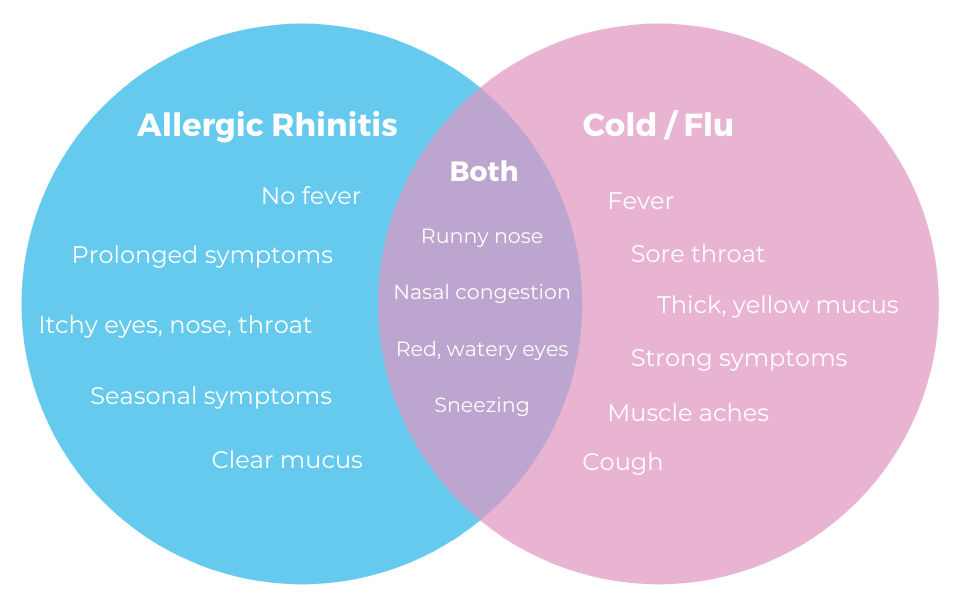Flu (Influenza) and common cold are among the most common illnesses caused by viral infection, affecting children and young adults. Flu can be more severe than common cold as it takes a longer time to recover. Influenza viruses attack your respiratory system which includes your nose, throat and lungs.
Since the 2009 flu pandemic in Malaysia caused by Influenza A virus (H1N1), it has become a seasonal disease that has affected many lives. Therefore, it is important to build your immune system and undergo early treatment before the viral infection worsens.
However, having an allergy is different because it is usually not treated but controlled. This means that it requires proactive steps to prevent allergy from flaring up, rather than undergoing treatment to recover. The best option is to avoid contact with allergens.
Did You Know?
Another disease known as Allergic Rhinitis is often mistaken for the flu because it shares very similar symptoms.
What is Allergic Rhinitis?
It is a condition whereby a person’s immune system overreacts when in contact with allergens such as grass, dust mites, pet’s fur, and pollen. It is not caused by viruses as seen in flu or common colds. Despite having an alternative name for this condition which is Hay Fever, the person does not show signs of fever.
So how do you know if you’re actually having allergic rhinitis, or contracted a flu?

While many consider allergic rhinitis as a common allergy, it is linked to an individual’s cognitive processes such as thinking, reading, remembering, and problem-solving. If left untreated, it can impair a person’s ability to process information and perform optimally in daily routines.
Your Genes Can Predict The Risk
Today, the risk of developing allergic rhinitis can be determined by looking at your DNA.
One of the genes that is linked to this condition is IL-4 (Interleukin 4). It is a gene that triggers the immune system to produce chemicals that help to fight harmful substances entering the body.
Changes in this gene will lead to allergic reactions whereby a harmless substance such as pet’s fur is perceived as harmful to the body. There is an increased risk of developing allergic rhinitis in individuals who have this genetic variation.
According to a study by Chong and Chew (2018), allergic rhinitis is prevalent in Asia.
A critical risk factor is associated with pet adoption that is common among Asian households. Personal risk factors such as stress are also known to have an impact on the expression of this gene. It is observed in the study that the lifestyle of most Asians nowadays are stressful and hectic.
Tips To Prevent Allergy or Flu Symptoms
1. Stay hydrated
Drink at least 6-8 glasses of water every day for good health. Take more juicy fruits like watermelon, apples, oranges and pineapples that are a good source of water and Vitamin C. Overall, they can provide that extra boost to your immune system in fighting flu/allergy symptoms.
2. Maintain good personal hygiene
Remember to regularly wash your hands thoroughly with soap to remove any potential allergens. Cover your mouth when you sneeze to prevent the spread of the flu virus.
3. Keep your home clean and tidy
Wash your laundry, bed sheets, and pillow cases regularly with hot water and detergent. Vacuum your floor and sofas as well. Clean surfaces help to reduce growth of dust mites, bacteria, and virus.
4. Maintain good air circulation
You can install a dehumidifier in your home to keep humidity low, thus preventing the growth of microorganisms. Also, clean air-conditioners and fans on a regular basis to maintain good air quality around the house.

5. Keep pets out of bedroom
For most pet owners, they would always want to sleep with their pets. However, pet’s dander is a common problem for those with allergic rhinitis. Keeping them out of your bedroom to reduce allergens on the bedding is a necessary preventive measure.
In a nutshell, both allergic rhinitis and flu can cause harm to your body. Hence, it is important to understand the risks and take preventive measures before falling sick.
Make Changes to Your Lifestyle Today!
For more information about your genes, feel free to check out our website here or drop us a message on Facebook.
REFERENCES
Alho, OP, Karttunen, R & Karttunen, TJ 2004, ‘Nasal mucosa in natural colds: effects of allergic rhinitis and susceptibility to recurrent sinusitis’, Clinical & Experimental Immunology, vol. 137, no. 2, pp. 366-372.
Chong, SN & Chew, FT 2018, ‘Epidemiology of allergic rhinitis and associated risk factors in Asia’, The World Allergy Organization Journal, vol. 11, no. 1, pp. 1-24.
Church, D, Church, M & Scadding G 2020, ‘Allergic rhinitis: impact, diagnosis, treatment and management’, Pharmaceutical Journal.
Small, P & Kim, H 2011, ‘Allergic rhinitis’, Allergy, Asthma & Clinical Immunology, vol. 7, no. 1, pp. 1-21.
Tongtako, W, Klaewsongkram, J, Mickleborough, TD & Suksom, D 2018, ‘Effects of aerobic exercise and vitamin C supplementation on rhinitis symptoms in allergic rhinitis patients’, Asian Pacific Journal of Allergy and Immunology, vol. 36, no. 4, pp. 222-231.
U.S. National Library of Medicine 2020, IL4 Gene, viewed 16 January 2020, https://ghr.nlm.nih.gov/gene/IL4#normalfunction.

